

WHERE DO MANGROVES GROW?
Mangroves
Mangroves grow in tropical regions at river mouths, bays, coastal lagoons and islands. Mangroves are common in the Florida Keys: they create a fringing network around most islands and grow at hundreds of shallow locations offshore.

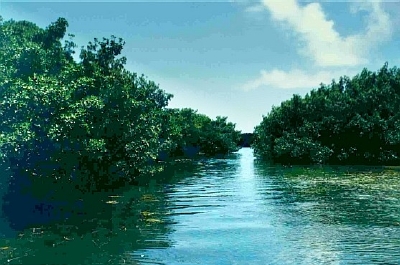
WHAT IS A MANGROVE?
Mangroves are a community of tropical trees and shrubs that have adapted to a salt-water environment. Mangroves play a critical role as part of the interdependent coral reef ecosystem. 74% of the game fish and 90% of the commercially valuable sea life in South Florida depend on Mangroves.
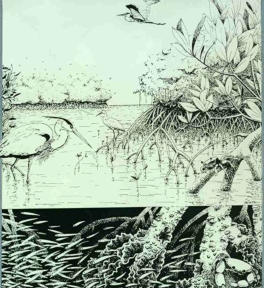
WHY ARE MANGROVES IMPORTANT?
Mangroves trap debris and silt, stabilizing the near shore environment and clarifying adjacent open water, which facilitates photosynthesis in marine plants. The fringing network on Mangroves buffers natural forces such as hurricanes, wave action, tidal change and run-off, preventing soil loss with its firm, flexible barrier.
MANGROVES ARE NUTRIENT PRODUCERS that shed and drop about seven and a half tons of leaf litter per acre per year. The constantly-shed leaves are quickly broken down by bacteria and fungi and released into the water, providing food for sea-life.
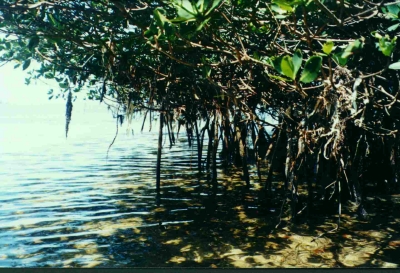
MANGROVES ARE AN IMPORTANT NURSERY FEEDING GROUND for juvenile fish and invertebrates such as spiny lobster, gray snapper, jacks and barracuda. Mangroves are the nesting grounds for many water birds such as the great white heron, reddish egrets, roseate spoonbills, cuckoos, white-crowned pigeons and frigate birds. Even dwarf key deer are mangrove lovers, and the tree leaves make up a large percentage of their daily diet.
MANGROVE PROP ROOTS PROTECT AND OFFER HABITAT for mammals, amphibians, reptiles, countless unique plants, juvenile fish and invertebrates that filter water such as sponges, barnacles, oysters, mussels, crab, shrimps, and oysters.
MANGROVES FILTER FROM GROUNDWATER AND STORM WATER RUN-OFF that contain harmful pesticides, herbicides, hydrocarbons and heavy metals. Mangroves also recharge underground water supplies by collecting rainwater and slowly releasing it.
MANGROVES AFFORD RECREATION to hunters, fishermen, bird-watchers, photographers and others who treasure natural areas. However, the intrusive actions of noisy jet-skis, happy campers and others who disturb nesting and breeding areas, chop down mangroves and otherwise damage this fragile environment, threaten its existence.
COMMON MANGROVE SPECIES IN THE FLORIDA KEYS
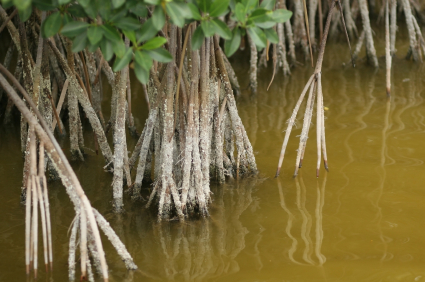
Red Mangroves
RED MANGROVES (Rhizophora mangle) Characterized by aerial roots concealed props roots which provide support for soft muds and stabilize elements. In the Lower Keys, they create dwarf forests where the cap rock is at or near the surface, the soil sparse, tidal flushing sporadic and nutrients poor.
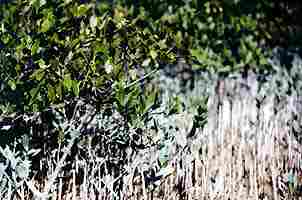
Black Mangroves
BLACK MANGROVE (Avicenia germinans) Occur shoreward to the Red Mangrove and are characterized by the presence of small pencil-like vertical root shots call pneumatephores. These root shots stand in dense arrays near the high-tide line, enabling the Mangrove to obtain oxygens directly from the air. Until flushed by rain, their leaves are whitish on the underside with excreted salt.
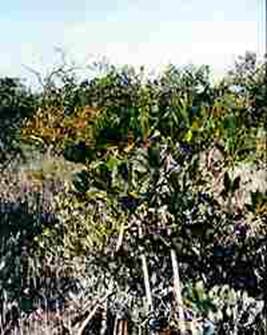
White Mangroves
WHITE MANGROVES (Laguncularia racemosa) Grow on elevated grounds above the high-tide mark and behind the Red and Black Mangroves. The leaves are thick and succulent, rounded at both ends, and the same color on both sides. The root system resembles that of most terrestrial trees and seldom show breathing roots.
THREATS TO MANGROVES
LARGE HURRICANES
Hurricane Donna, in 1960, damaged an area of 100,000 acres of the Mangrove zone of South Florida. Loss of trees ranged from 25% to 100% from shearing the trunks above ground, complete overwash of islands and prop root damage from marl and fine organic matter coating the roots.
SHORELINE DEVELOPMENT has replaced Mangroves with marinas, dredged channels, airports, filled lots, seawalls and other commercial and residential construction. 60 percent of shallow water open Mangroves in the Upper Keys were lost between 1965 and 1985. 40 percent of that was due to dredging and filling of Mangroves.
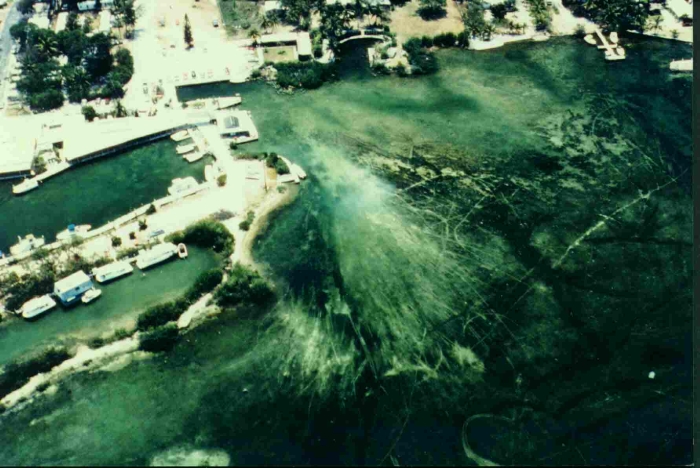
Photo by Curtis Kruer, Florida Keys
This loss is not restricted to the Florida Keys -- other areas, such as Tampa Bay, Marco Island and the lower coast of Florida, have lost mangroves. Approximately 11,000 acres were lost between 1943 and 1970 in Collier, Monroe and Dade counties alone, of a total of 430,000-500,000 acres in all of Florida. While not overwhelming, losses at specific locations have been substantial.
Mangroves have been lost due to shrimp farming throughout the Phillippines and other parts of Asia.
OTHER THREATS are illegal dumping, beach renourishment, oil spill, agricultural run-off that contains herbicides, pesticides, and sugar cane wastes. Man-made canal systems have altered fresh water run-off in the Florida Everglades, dramatically changing salinity levels and lowering the water table.
If the biota, in the course of aeons, has built something we like but do not understand, then who but a fool would discard seemingly useless parts? To keep every cog and wheel is the first precaution of intelligent tinkering. Aldo Leopold, Round River, 1993.
Reef Relief Founders.com


